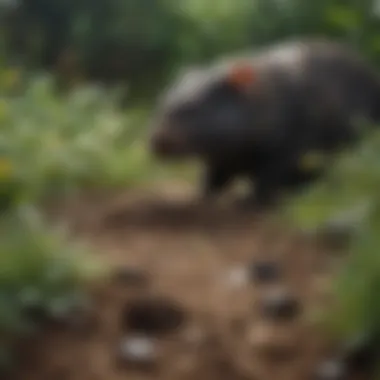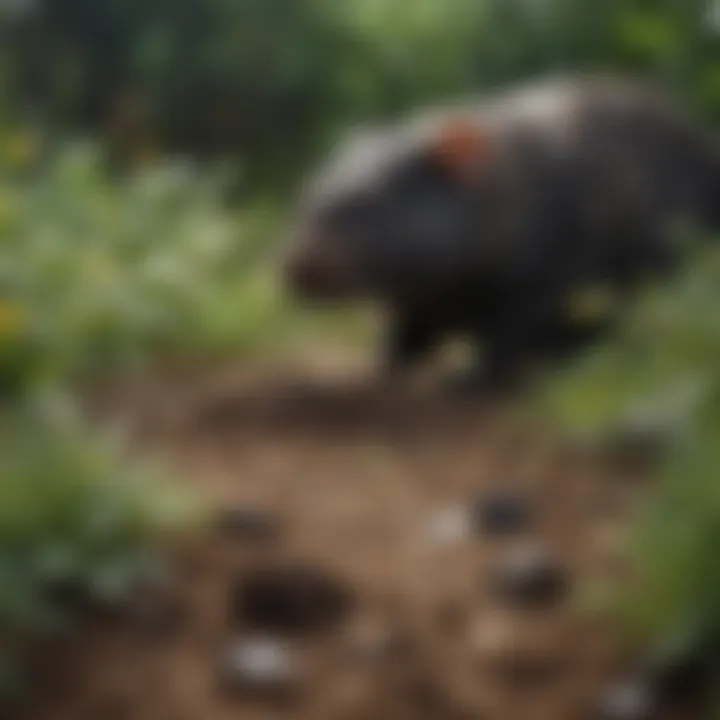Effective Strategies to Keep Moles Out of Your Yard


Intro
Moles can be a nuisance for homeowners and gardening enthusiasts alike. These small mammals are known for their tunneling behavior, which can disrupt the aesthetics of gardens and lawns. As they dig underground, they create unsightly mounds and compromise the root systems of plants. Understanding how to effectively keep moles out of your yard is essential for maintaining a healthy and vibrant outdoor space.
This article will explore various practical and evidence-based strategies to prevent mole invasion. By discussing environmental modifications, deterrent techniques, and insights into mole behavior, this guide aims to provide readers with a comprehensive understanding of how to safeguard their yards while promoting a balanced ecosystem.
Design Inspiration
While the main goal is to keep moles out, it is also valuable to consider how adjustments to your yard's design can impact the overall health of your outdoor space. An appealing yard contributes to your home’s curb appeal and can deter moles naturally.
Trending Styles
Moles prefer environments that offer abundant food sources like grubs and worms. To steer them away, consider adopting a landscape design that minimizes these food sources. Incorporating more native plants that attract beneficial insects can help regulate pest populations, thus reducing the attractiveness of your yard to moles.
Color Palettes
The color choices in your landscaping can create a visual barrier that may help in discouraging moles. Using lighter-colored materials for mulch or decorative stones can alter the visual landscape, providing an uninviting look for moles. Additionally, maintaining a lush, green appearance signifies health and vitality. Healthy grass can also deter moles as they often prefer disturbed soil for their tunneling.
Practical Tips
Keeping moles out of your yard requires a blend of proactive and reactive measures. Below are practical tips to help you succeed in this endeavor.
Maintenance & Care
Regular yard maintenance is critical. Here are some strategies to consider:
- Aerate the Soil: Moles require soft earth for burrowing. By aerating, you can make the soil less appealing.
- Control Grubs: Use nematodes or beneficial insects to manage grub populations naturally, lowering the food source for moles.
- Regularly Tidy Up: Keeping the garden clean reduces habitat that can attract other burrowing critters that moles prey upon.
Budgeting & Planning
While it can be tempting to reach for chemical deterrents, it is important to plan an ecological approach that is both effective and budget-friendly.
- Invest in Natural Deterrents: Products like castor oil can be mixed with water and sprayed to deter moles without harming other wildlife.
- Consider Physical Barriers: Installing underground fences using wire mesh can provide a long-term solution that might require initial investment but pays off over time.
Keeping a close watch on mole activity during early stages can also help ensure effective intervention before they establish a significant presence in your yard.
Understanding Moles: Behavior and Habitat
Understanding the behavior and habitat of moles is crucial for effective management strategies as outlined in this guide. When homeowners know how moles live and act, they can implement measures that address the specific preferences and routines of these animals. It helps in identifying the right methods to deter moles from invading your yard and allows for an informed approach to gardening.
The Role of Moles in the Ecosystem
Moles play an important role in the ecosystem. They are known for aerating the soil as they tunnel through it. This process can be beneficial for plant life because it helps water reach deeper roots. Moles also help control insect populations. They consume a variety of pests such as grubs and earthworms, which can keep gardens healthy by reducing the likelihood of pest outbreaks.
However, these benefits are often overshadowed by the damage moles can cause in residential yards. Their tunnels and mounds can disrupt the aesthetics of lawns and gardens. Homeowners must weigh the ecological advantages against the visible impact these animals have on their property. Understanding this balance can lead to better decision-making when developing strategies to keep moles out.
Common Traits of Moles
Moles have distinct characteristics that set them apart from other garden nuisances. Here are some common traits:
- Adapted Physique: Moles possess cylindrical bodies with short legs. Their front limbs are muscular and spade-like, which are perfectly designed for digging.
- Poor Vision: Moles have nearly blind eyesight but excellent senses of touch and smell. This makes them rely on vibrations and scents in their environment to navigate and hunt.
- Active Lifestyle: They are generally active throughout the year, mainly during cooler parts of the day. Moles spend most of their time underground, which can make them challenging to spot.
These traits assist in understanding their behavior and living patterns. This knowledge aids homeowners in discerning the signs of mole presence and planning effective deterrent strategies.
Mole Habitat Preferences
Moles favor habitats that include moist, loose soil that is rich in organic matter. Here are the primary preferences:
- Soil Type: They thrive in sandy or loamy soils which are easier to tunnel through. Compacted or rocky soils are less conducive for mole activity.
- Moisture Availability: Areas with adequate moisture attract moles as it supports healthy populations of earthworms and insect larvae—primary food sources for them.
- Vegetation: Moles are drawn to gardens and lawns that have plentiful vegetation, as it often signifies a rich ecosystem below the surface.
Recognizing these preferences is vital for homeowners. By modifying the landscape and soil conditions, it is possible to create less hospitable environments for moles.
Identifying Signs of Mole Activity
Identifying signs of mole activity is crucial for homeowners seeking to protect their yards. Early detection helps in implementing deterrent strategies before moles cause significant damage. Understanding mole behavior and the indicators of their presence can lead to effective management and prevention measures.
Recognizing Mole Tunnels
Moles are renowned for their tunneling behavior, which creates intricate networks beneath the surface of the soil. The most clear-cut sign of mole activity is the appearance of these tunnels.
Typically, you can recognize these tunnels by their distinct surface ridges, which may appear as raised lines in the soil. These ridges are often shallow and do not typically disrupt the grass above, unlike the larger mounds created by other burrowing animals. It’s essential to inspect your yard during the spring and fall, as this is when moles are most active.
Furthermore, when walking through your yard, a crunchy sensation underneath your feet might signal the presence of tunnels. Noticing these signs early can prevent further infestation.


Identifying Surface Mounds
While tunnels are crucial indicators, surface mounds also denote active mole populations. These mounds, often circular and formed from loose soil, occur when moles push the soil to the surface as they dig. One mole can produce several mounds in a short period.
When observing these mounds, you will notice they range in size, typically measuring around six to twelve inches in diameter. The dirt is generally loose and can be easily disturbed. By mapping where the mounds appear over time, homeowners can track mole movement within their yard. This behavior can inform targeted deterrent strategies.
Assessing Yard Damage
The assessment of yard damage due to mole activity is vital for understanding the extent of the issue. Moles primarily feed on grubs and insects in the soil, which means their activity can cause indirect damage to plants. Evidence of this damage can be seen when roots are disturbed and grass becomes patchy or brown, suggesting poor health.
In particular, if you notice dead patches of grass, it could be linked back to moles’ tunneling habits disrupting the root systems of your plants. This aspect is significant, as maintaining a healthy yard involves understanding the impact of these activities.
By discerning the signs of mole activity—both physical and indirectly—homeowners can act effectively in keeping moles at bay. Monitoring these features will enhance your defense against these unwelcome garden residents.
Environmental Modifications to Deter Moles
Adjusting the yard environment can significantly reduce the chances of moles taking residence in your garden. Moles are opportunistic feeders, drawn to areas rich in earthworms and insects. By modifying the landscape and soil conditions, homeowners can create an unwelcoming territory for moles. Modification strategies are effective because they focus on preventing attraction rather than direct confrontation.
Maintaining Soil Health
Choosing the Right Soil Type
Choosing the right soil type is vital for keeping moles away. Moles prefer loamy, moist soil where they can easily dig and find food. Conversely, sandy or clay-heavy soils are not conducive to their habits. A lighter, sandy soil is less attractive since it does not hold as many earthworms. This adjustment in soil composition can deter moles effectively.
Proper Drainage Techniques
Proper drainage techniques benefit yard health and deter moles by reducing moisture levels. Moles thrive in wet conditions where earthworms are abundant. Implementing drainage solutions, such as French drains or surface grading, helps keep the soil drier, thereby lowering mole activity. This, in turn, creates an environment less favorable for them.
Organic Matter Applications
Adding organic matter, such as compost, can be a double-edged sword. While it improves soil structure and moisture retention, it can also attract earthworms. Homeowners should balance the amount of organic matter used in their gardens. Too much can invite moles, while insufficient amounts might not promote healthy growth. Selecting the right type and quantity of organic matter will optimize benefits without attracting moles.
Landscaping Choices to Reduce Attraction
Landscaping choices can effectively minimize mole attraction, steering them away from your yard. A focus on plant selection and ground cover can change the allure of the area entirely.
Selecting Non-Preferred Plants
By selecting non-preferred plants, homeowners can create an environment that is less inviting to moles. Plants such as lavender or marigolds are known for their deterrent properties. They have strong scents that can repel moles and their food sources. Integrating these plants into the landscape can significantly reduce the likelihood of mole infestations.
Implementing Ground Covers
Implementing ground covers is another tactic to deter moles. Dense ground covers like creeping thyme or clover can limit the open spaces moles prefer to inhabit. A full coverage layer can prevent them from tunneling below. However, it is essential to maintain these covers properly to ensure they do not give way to more attractive alternatives.
Gravel and Mulching Strategies
Gravel and mulching are effective strategies that add an extra layer of difficulty for moles. Using sharp stones or coarse gravel as mulch can make tunneling uncomfortable for them. This tactic may discourage moles from trying to dig through. Furthermore, wood chips or straw also serve as barriers by creating a less favorable environment for earthworms and other food sources for moles.
"By modifying your yard's environment thoughtfully, you can create conditions that dissuade moles from making themselves at home."
Adjusting soil and landscape characteristics involves careful thought and consideration. Each element, from the type of soil used to the choice of plants and ground cover, plays a vital role in creating an unwelcoming habitat for moles.
Utilizing Natural Deterrents
Utilizing natural deterrents is an effective strategy for keeping moles at bay. This approach not only addresses the immediate issue of mole intrusion but also promotes a healthier and more balanced ecosystem in your yard. By incorporating natural elements, homeowners can deter these creatures without relying on harsh chemicals or traps that might harm surrounding wildlife. The natural deterrents serve multiple benefits, including easier integration into gardening practices and the ability to create a more inviting environment for beneficial insects and other small creatures.
Plants That Repel Moles
Certain plants possess natural properties that can repel moles. Incorporating them into your landscaping can create a barrier against pest invasions. For example, marigolds are known for their strong scent that moles find unappealing. Similarly, plants like daffodils and garlic can serve the same purpose. Their presence not only beautifies your garden but also acts as a deterrent. Additionally, castor bean plants release ricin, a substance that discourages moles through its toxicity. However, caution is needed as castor beans can be dangerous to pets and humans if ingested.
Recommended Plants:
- Marigolds
- Daffodils
- Garlic
- Castor Bean
Using Essential Oils and Scents
Essential oils can also be effective in repelling moles. These oils, known for their intense aromas, can mask the scents that moles rely on for navigation and hunting. For example, peppermint oil and rosemary oil are commonly used options. Homeowners can dilute these oils with water and spray them around mole-prone areas. Not only does this method reduce mole presence, but it can also enhance the fragrance of your garden space. Make sure to refresh the application regularly, especially after heavy rainfall, as the scent can diminish quickly.
Application Tips:
- Mix a few drops of essential oil with water in a spray bottle.
- Spray the mixture around the edges of your garden.
- Reapply after rain or every few weeks for maximum effectiveness.
Biological Control Options
Biological control refers to using natural predators or competitors to keep moles under control. Introducing or attracting predators, such as barn owls or hawks, can drastically reduce mole populations. These birds can often be a natural deterrent, as they hunt moles as part of their diet. Installing platforms for birds of prey to perch upon may encourage them to visit your yard more frequently. Furthermore, reducing vegetation that provides cover for moles can also enhance the effectiveness of this method. Maintaining a more open yard can discourage moles from establishing a habitat.


"Biological control offers a sustainable way to manage pest populations, aligning with broader environmental goals."
Finale
By making these small adjustments, homeowners can enjoy their outdoor spaces free from the disturbances caused by moles.
Mechanical Barriers and Traps
Mechanical barriers and traps are essential strategies in managing mole populations in residential areas. These methods focus on creating physical impediments or utilizing traps to eliminate the presence of moles more directly than environmental changes or repellents. They can be advantageous because they often yield immediate results compared to other long-term strategies, effectively addressing an existing problem.
Installing Underground Barriers
To deter moles effectively, installing underground barriers is a proven method. These barriers are typically made from solid materials such as wire mesh or galvanized steel. They are buried several inches underground and extend a few feet deep to prevent moles from burrowing underneath. This installation not only protects specific areas of your garden but also helps define boundaries, effectively keeping moles at bay.
The key characteristic of underground barriers is their permanence. Once in place, they provide ongoing protection without requiring frequent maintenance. However, this method can be labor-intensive during installation. Proper planning is crucial to ensure that barriers are placed correctly to prevent moles from bypassing them.
Choosing the Right Traps
Choosing the right traps is vital to the successful removal of moles. Traps designed for moles come in various types, each serving unique purposes. Understanding these differences can greatly enhance your pest management efforts.
Different Types of Traps
Different types of traps include scissor traps, harpoon traps, and tunnel traps. Each serves a distinct function, appealing to different user preferences and techniques.
- Scissor traps: Known for their strong mechanism, these traps usually deliver a quick kill. They can be effective in areas with higher mole activity.
- Harpoon traps: These traps spear the mole as it moves through their tunnels. They are ideal when trying to position them in active runs.
- Tunnel traps: These are placed directly in an existing mole tunnel, providing a less invasive way of trapping than those which disturb the ground surface.
The key advantage of these traps is their efficiency and effectiveness. They provide a definitive solution when installed correctly, delivering satisfactory results for homeowners seeking to manage mole problems.
Effective Trap Placement
Effective trap placement is critical for trapping moles successfully. This strategy requires understanding mole behavior and activity patterns. Placement in active tunnels significantly increases the chances of trapping success.
A key characteristic of effective trap placement is its focus on active runs. Identifying these paths can be done by observing areas with fresh soil and surface activity. This not only serves as a beneficial characteristic but ensures that traps are utilized to their fullest potential.
Unique to this aspect is the requirement for periodic monitoring. Traps must be checked regularly to account for successful captures and reset them as needed. This ensures ongoing management of mole populations.
Safety Considerations
When using traps, safety is an important aspect to consider. Ensuring that the traps do not pose a risk to pets or children should always be a priority. This often requires clear signage around the trapping area or using traps with safety features.
The distinctive characteristic in this case is the various designs that enhance safety. Some traps come with protective covers or specific mechanisms that reduce accidental activation. These features make traps a more reliable choice for families living in close quarters with children or pets.
Overall, balancing effectiveness with safety ensures that methods remain responsible and suitable for the environment. This approach aligns well with the broader objectives of maintaining an inviting yard while effectively controlling mole populations.
Chemical Repellents: A Cautious Approach
Chemical repellents can serve as one part of a comprehensive strategy to keep moles out of your yard. These substances aim to deter moles from entering your space through specific scents or flavors that they find unappealing. While they may offer some benefits, it is essential to approach their use with caution, understanding the potential risks involved as well.
Understanding Chemical Repellents
Chemical repellents typically contain a variety of active ingredients intended to create an environment that is less appealing to moles. Some common components include castor oil, ammonia, and certain essential oils. These substances may work by affecting the moles' sense of smell or taste, prompting them to seek food and shelter elsewhere. It's crucial to know that not all repellents will work equally well for every yard. Factors like soil type, moisture level, and existing vegetation can influence the effectiveness of specific products.
Potential Risks and Benefits
The decision to use chemical repellents should involve weighing the benefits against potential risks. Here are some points to consider:
Benefits:
- Accessibility: Chemical repellents are generally easy to find in gardening or home improvement stores.
- Immediate Impact: If applied correctly, they can create a quick deterrent effect.
- Variety of Options: There are many formulations available, giving homeowners choices based on preference or convenience.
Risks:
- Environmental Impact: Some chemicals may harm beneficial insects or plants. This can lead to unintended consequences in your yard.
- Effectiveness Issues: Not all moles respond to chemical repellents. Individual behaviors may vary, ultimately diminishing efficacy.
- Application Challenges: Improper application can result in the repellent becoming ineffective or causing harm to the surrounding flora and fauna.
Thus, it is crucial to understand each product's composition and any potential side effects it may bring to your property.
Application Guidelines
When considering chemical repellents, follow these guidelines to ensure responsible and effective use:
- Read the Label:
Always check product instructions carefully. This can prevent misuse and reduce the risk of damaging your garden. - Timing of Application:
Apply repellents during the early spring or late fall when moles are most active and searching for food. - Target Areas:
Focus on areas with fresh mole activity, such as visible tunnels or surface mounds. - Consistent Application:
Regular reapplication may be necessary, especially after rainfall or significant watering. - Follow Safety Protocols:
Use gloves and avoid contact with the skin. Keep children and pets away from treated areas until thoroughly dry.
Both potential users and non-users should remain informed about chemical repellents' role in an integrated pest management strategy. Their use should complement other deterrent methods instead of relying solely on them.


Remember: A comprehensive approach is vital. Utilize multiple strategies to ensure sustained yard health.
For further reading on pest management practices, visit Wikipedia or Britannica.
Exploring the potential of chemical repellents requires careful thought and planning. By understanding their application and associated risks, homeowners can make well-informed decisions suitable for their gardens.
Maintaining Long-Term Yard Health
Maintaining long-term yard health is essential for both aesthetics and functionality. A healthy yard not only looks attractive but also serves as a robust environment that can deter pests, including moles. Fostering optimal yard health can lead to a more resilient ecosystem, ensuring that plants thrive while minimizing the compounding issues that can arise from an unhealthy landscape. Key elements to consider include regular maintenance, seasonal adjustments, and promoting biodiversity.
Regular Lawn Maintenance Practices
Regular lawn maintenance practices play a critical role in keeping your yard in good shape. This includes mowing at the right height, watering appropriately, and fertilizing to promote strong grass growth. Grass that is well cared for is less likely to become a target for moles, who are often drawn to weak roots from a stressed lawn.
- Mowing: Keeping your lawn mowed at a recommended height can prevent overgrowth, which attracts pests and provides harbor for moles.
- Watering: Generating a consistent watering schedule ensures that your lawn maintains its vitality. However, overwatering can lead to root rot, making grass vulnerable to pests.
- Fertilization: Applying the right fertilizers helps maintain nutrient-rich soil, fostering healthy plant growth.
Seasonal Yard Care Tips
Adapting your yard care strategy according to the seasons is crucial. Each season presents unique challenges and opportunities for maintaining healthy soil and vegetation, which will discourage moles from settling in.
- Spring: Focus on aerating the lawn to improve root growth and nutrient absorption.
- Summer: Monitor your irrigation closely to avoid dry patches that may attract moles.
- Fall: This is a good time to prepare your yard for winter by overseeding and applying fertilizer.
- Winter: Protect your yard from heavy foot traffic and consider covering sensitive areas to maintain soil integrity.
Promoting a Balanced Ecosystem
Creating a balanced ecosystem is another cornerstone of maintaining long-term yard health. When diverse plant life is present, natural predators can help control the mole population.
- Plant Diversity: Cultivating a range of plants can create a more robust ecosystem that may deter moles. Consider native plants, as they usually require less maintenance.
- Soil Quality: Improve and maintain soil quality with organic amendments. Healthy soil supports strong root systems, which are less appealing to moles.
- Wildlife Encouragement: Encourage birds and beneficial insects that feed on pests, contributing to a natural control of the ecosystem.
A well-maintained yard provides a natural defense against moles and similar pests. Healthy grass and soil create unfavorable conditions for invasion.
By integrating these practices into your yard care routine, you can ensure that your outdoor space remains healthy, vibrant, and less prone to mole infestations.
The Role of Professional Help
Professional assistance can be a vital component when addressing mole infestations in residential yards. While many homeowners may attempt to solve the issue independently through various techniques, sometimes a professional's insight is beneficial for both immediate and long-term outcomes. Experts in pest control bring a wealth of knowledge that encompasses understanding mole behavior, habitat, and effective management strategies. This comprehensive understanding can lead to efficient solutions tailored to specific yard conditions, significantly improving the chances of success in keeping moles at bay.
When to Consult an Expert
There are several circumstances when consulting a professional is advisable. For example:
- Persistent Activity: If you observe ongoing mole activity despite trying common deterrents like natural repellents or landscaping modifications, it may be time to seek expert advice.
- Uncertain Identification: If you are unsure whether your yard is affected by moles or other pests, an expert can accurately diagnose the situation and recommend appropriate measures.
- Widespread Damage: When the physical damage in your yard is significant, resulting in excessive lawn repair costs, enlisting a professional may save you in the long run.
Introducing a professional into the situation not only brings immediate expertise but also provides access to advanced tools and techniques that are generally not available to homeowners.
Assessing Pest Control Services
Choosing the right pest control service requires careful consideration. Homeowners should assess several factors:
- Reputation: Look for companies with positive reviews and a history of effective mole removal. Checking online platforms like Reddit or Facebook for community recommendations can be helpful.
- Methods Used: Ensure the service employs humane and environmentally friendly pest control techniques. Many professionals are now focused on sustainable practices that align with your desire to maintain a balanced ecosystem.
- Cost Estimates: Request detailed quotes that outline expected services. It's crucial to compare costs while ensuring quality service is not sacrificed for a cheaper option.
"A reputable pest control service will not only eliminate the immediate issue but also provide guidance on preventing future infestations."
Evaluating Effectiveness of Professional Solutions
After hiring a professional pest control service, it is important to evaluate the effectiveness of their interventions. Homeowners should consider the following aspects:
- Results Assessment: Monitor the yard for signs of mole activity after treatment. If problems persist beyond a reasonable timeframe, revisit the service to discuss follow-up actions.
- Application of Strategies: A good service will provide recommendations for long-term management to prevent future infestations. Applying these strategies consistently is key to maintaining a mole-free yard.
- Sustainability Focus: Reflect on how the solutions align with your values regarding ecological balance. Services that promote sustainable practices yield benefits beyond mere pest control, enhancing garden vitality.
In summary, professional help serves as a powerful ally in the fight against moles. Understanding when to seek expertise, meticulously choosing a competent service, and evaluating results can significantly impact the success of mole management in residential yards.
Addressing Common Misconceptions
Understanding common misconceptions about moles is a crucial part of developing a comprehensive strategy to combat their invasion in yards. The myths surrounding moles can lead to ineffective management techniques, resulting in frustration for homeowners. Addressing these misconceptions helps clarify the behavior of moles and highlights effective deterrence methods. This section will illuminate why recognizing the difference between moles and other pests, like voles, is essential.
Misconceptions can create a disconnect between reality and the actions people take. Many homeowners may believe that moles are destructive pests that only damage the surface of the lawn, when in fact their tunneling behavior can significantly benefit soil aeration and pest control. By dispelling myths and clarifying facts, property owners can approach the issue with informed strategies instead of misguided emotions. This leads to more effective results in maintaining the health of their yards.
Moles vs. Voles: Understanding the Difference
Moles and voles share superficial similarities, but their behaviors and impacts are quite distinct. Understanding these differences is vital for effective pest management.
- Moles are primarily solitary creatures that dig tunnels to search for insects and earthworms for food. They can cause surface mounds and tunnels but generally do not harm plant roots directly.
- Voles, on the other hand, are social and tend to feed on grasses and roots, causing visible damage to plants. They create surface runs in grass but do not dig deep tunnels like moles.
The confusion can lead homeowners to treat mole issues with inappropriate methods designed for voles. For example, methods for trapping voles, which often focus on surface-level activity, may not affect moles, which operate underground. This misapplication can cause wasted resources and unresolved problems. Recognizing these differences can help in aligning pest control methods effectively.
Dispelling Myths About Moles
Several myths about moles are ingrained in popular thinking yet lack factual support. Engaging with facts helps in addressing these misconceptions clearly. Some common myths include:
- Moles are highly destructive to lawns: While moles do create tunnels that can damage grass aesthetics, their presence can also contribute to soil health by aerating it and controlling pest populations like grubs and larvae.
- Moles are attracted to particular plants: This is misleading. Moles search primarily for food, which comprises insects and worms. They do not have a preference for plants.
- Killing moles is the only solution: Many methods can deter moles without eliminating them. Creating an inhospitable environment combined with physical barriers can effectively manage mole populations.
By understanding and addressing these misconceptions, homeowners can engage in a more productive dialogue about how to manage their yards responsibly. This allows for a balanced ecosystem where conflicts with wildlife like moles can be managed thoughtfully.















